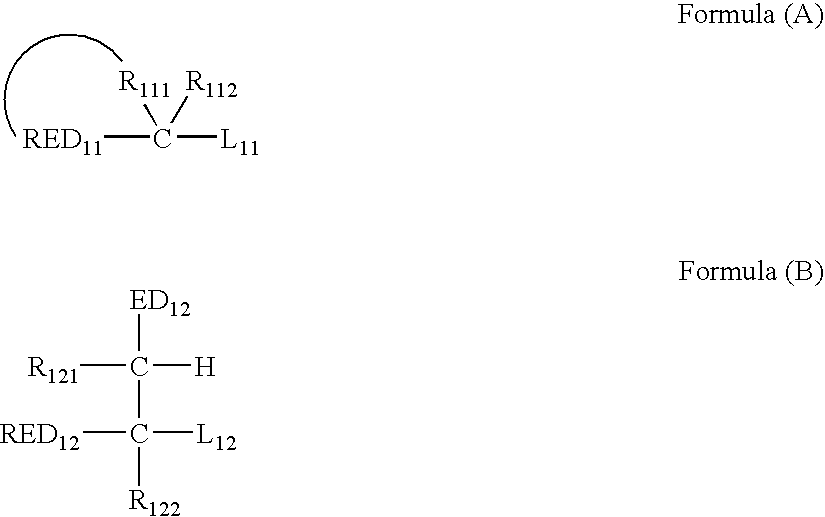Photosensitive silver halide photographic emulsion, and heat-developable photosensitive material
a technology of silver halide and photographic emulsion, which is applied in the field of silver halide photographic emulsion and heat-developable photosensitive materials, can solve the problems of not knowing the advantages and disadvantages of timing for applying reduction sensitization, and recording materials are not yet satisfactory in terms of image quality
- Summary
- Abstract
- Description
- Claims
- Application Information
AI Technical Summary
Benefits of technology
Problems solved by technology
Method used
Image
Examples
example 1
1) Preparation of Silver Halide Emulsion
Emulsion A
[0453]724 ml of an aqueous solution containing 74 g of silver nitrate and 800 ml of an aqueous solution containing 113 g of potassium iodide were simultaneously added to a reaction vessel containing 1400 ml of water at 55° C. containing 36 g of gelatin over 200 minutes by a controlled double jet method, while the content in the vessel was stirred. In the addition, the silver potential was kept at +60 mV until the addition amount of silver nitrate reached 22 g and thereafter the silver potential was kept at +220 mV. Then, desalting and washing with water were conducted and additional gelatin was added to the resultant. Thereafter, pH of the resultant mixture was adjusted to 5.0 and pAg to 5.2. Thus, a silver iodide particle emulsion was obtained. Silver iodide particles in the emulsion had an average grain size of 0.09 μm and a fluctuation coefficient of the grain size of 18%.
Emulsion B
[0454]After preparing silver iodide emulsion part...
example 2
1) Preparation of Silver Halide Emulsion
Emulsion F
[0466]Emulsion F was prepared in the same manner as the preparation of Emulsion A except that, after keeping the silver potential at +220 mV, an aqueous solution of potassium bromide was simultaneously added to the system so that the amount of the aqueous solution corresponded to 5 mol % with respect to the silver nitrate. The resultant silver bromoiodide particles before desalting had a particle silver size of 0.11 μm and a fluctuation coefficient of the size of 24%.
Emulsion G
[0467]After preparing silver bromoiodide particles and desalting and washing with water in the same manner as those in Emulsion F, 64 μmol, per mol of the silver halide, of dimethylamine borane and 200 μmol, per mol of the silver halide, of a tellurium sensitizer (bis(N-phenyl-N-methylcarbamoyl telluride) were added to the resultant emulsion and the resultant was aged at 55° C. for 150 min.
Emulsion H
[0468]Emulsion H was prepared in the same manner as the prepar...
example 3
1. Preparation of PET Support
1) Film Preparation
[0472]PET was made of terephthalic acid and ethylene glycol in an ordinary manner, having an intrinsic viscosity, IV, of 0.66 (measured in a mixture of phenol and tetrachloroethane at an weight ratio of 6 / 4 at 25° C.). This was pelletized, and the resultant was dried at 130° C. for 4 hours, and melted at 300° C. The PET melt was extruded out from a T-die, and rapidly cooled. Thus, a non-oriented film whose thickness was so controlled that the thickness after thermal fixation was 175 μm was prepared.
[0473]The film was longitudinally oriented by rolls rotating at different circumferencial speeds at 110° C. so that the longitudinal length thereof after the orientation was 3.3 times as long as the original longitudinal length thereof. Next, the film was laterally oriented by a tenter at 130° C. so that the lateral length thereof after the orientation was 4.5 times as long as the original lateral length thereof. Next, the oriented film was ...
PUM
 Login to View More
Login to View More Abstract
Description
Claims
Application Information
 Login to View More
Login to View More - R&D
- Intellectual Property
- Life Sciences
- Materials
- Tech Scout
- Unparalleled Data Quality
- Higher Quality Content
- 60% Fewer Hallucinations
Browse by: Latest US Patents, China's latest patents, Technical Efficacy Thesaurus, Application Domain, Technology Topic, Popular Technical Reports.
© 2025 PatSnap. All rights reserved.Legal|Privacy policy|Modern Slavery Act Transparency Statement|Sitemap|About US| Contact US: help@patsnap.com



